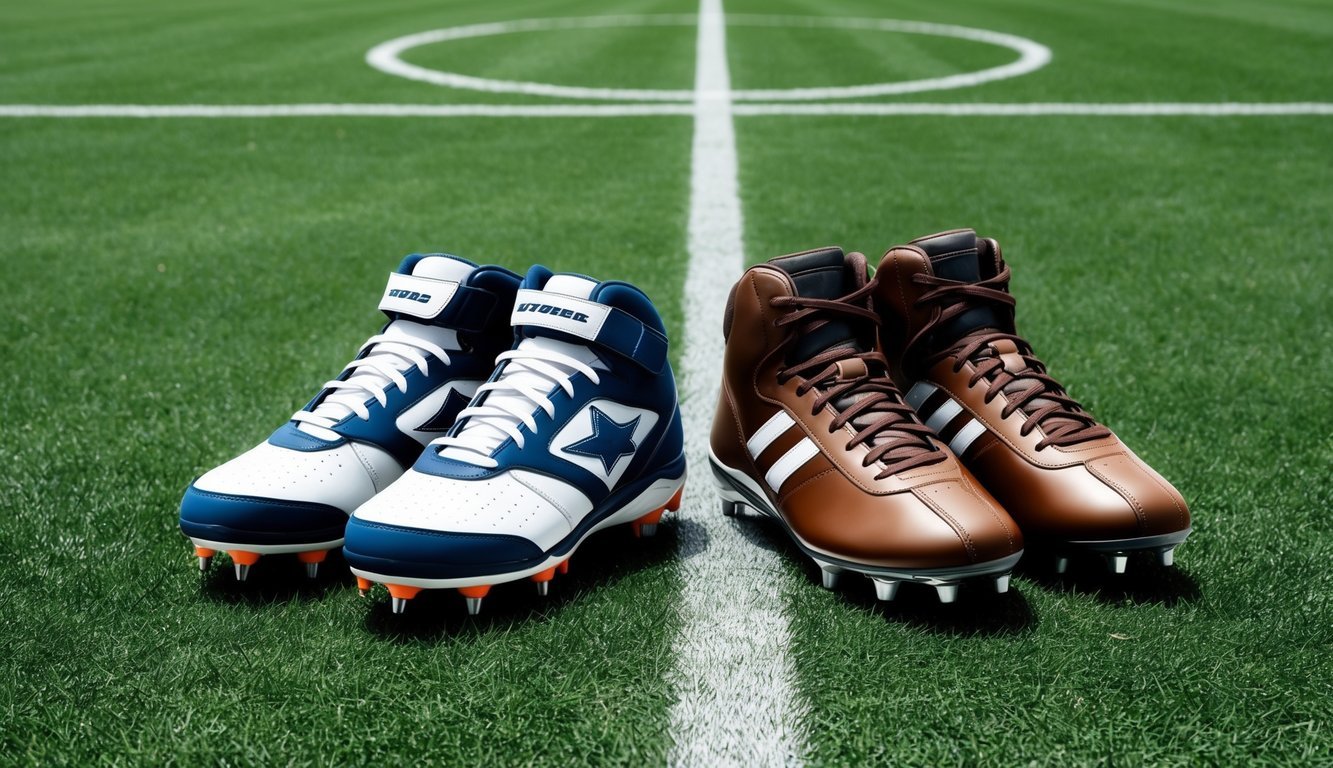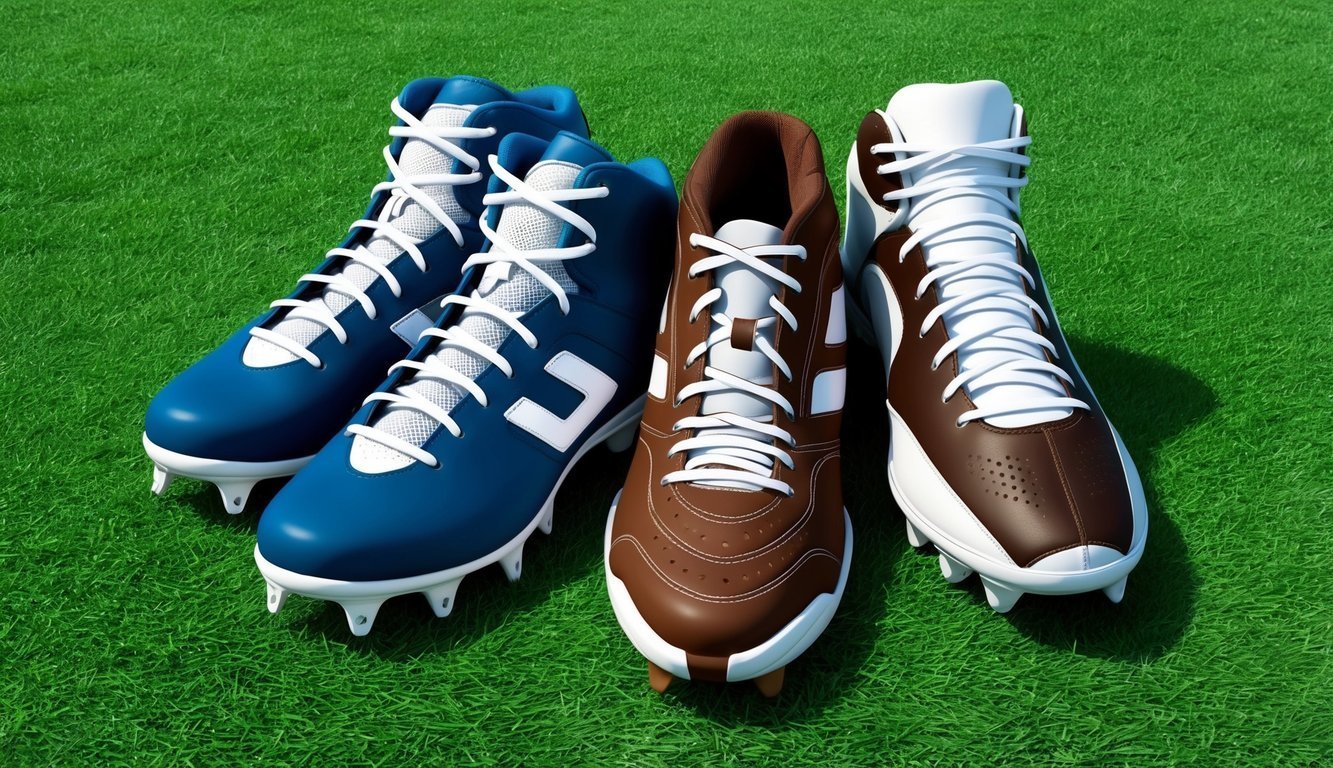Baseball and football are two of America’s favorite sports, each requiring specialized footwear for optimal performance.
While both sports use cleats, there are key differences between baseball and football cleats that players should be aware of.
Baseball cleats are designed with a low-cut upper and metal spikes for better traction on dirt and grass.
Meanwhile, football cleats typically have a higher ankle support and molded or detachable plastic studs for grip on various field conditions.
The support provided by each type of cleat is tailored to the movements common in their respective sports.
Baseball players need flexibility for quick bursts of speed and lateral movements when fielding, batting, and base running.
Football players, on the other hand, require more ankle stability for sudden changes in direction, tackles, and explosive starts.
Choosing the right cleats can significantly impact a player’s performance and safety on the field.
Understanding these differences helps athletes select the appropriate footwear for their sport, ensuring they have the necessary traction, support, and comfort to excel in their game.
Understanding Cleats
Cleats are specialized athletic footwear designed to provide traction and stability on various playing surfaces.
They feature protrusions on the outsole that dig into the ground, enhancing performance for athletes in specific sports.
The Basics of Cleats
Cleats come in different shapes, sizes, and configurations depending on the sport.
Baseball cleats typically have metal or molded plastic spikes arranged in a specific pattern on the outsole.
Meanwhile, football cleats often have more numerous, shorter studs distributed across the sole.
The placement of cleats affects how players move on the field.
Baseball cleats focus on forward motion and quick starts, while football cleats allow for multidirectional movement.
The height of the cleats can vary too, with some offering more ankle support than others.
Comfort is crucial in cleat design.
Many feature cushioned insoles and padded collars to reduce friction and provide support during long games or practices.
Cleats and Sport-Specific Design
Baseball cleats are tailored for the unique movements of the sport.
They often have a toe cleat for digging into the dirt when batting or pitching.
The cleats are generally longer to provide better traction when running bases or fielding.
Football cleats are designed for quick cuts and changes in direction.
They usually have a more robust construction to withstand the physical nature of the sport.
Some football cleats feature an extra stud near the big toe for added grip during push-offs.
The design of cleats can significantly impact a player’s performance.
Baseball players benefit from cleats that allow for smooth pivoting, while football players need cleats that provide stability during tackles and sudden stops.
Materials and Construction
Cleat uppers are made from various materials, each offering different benefits.
Leather is durable and molds to the foot over time, providing a custom fit.
Synthetic leather offers similar benefits at a lower cost and weight.
Mesh panels are often incorporated for breathability, keeping feet cool during intense play.
The outsoles are typically made of durable plastic or rubber to withstand constant contact with rough surfaces.
Metal cleats, popular in baseball, offer superior traction but are not allowed in some leagues due to safety concerns.
Molded plastic cleats are more versatile and can be used on different field types.
The construction of cleats aims to balance durability with flexibility.
Reinforced toe boxes protect against impacts, while flexible midsoles allow for natural foot movement during play.
Design Specifics for Baseball Cleats

Baseball cleats are engineered for optimal performance on the diamond.
They incorporate key features to enhance player stability, traction, and agility during gameplay.
Support and Stability Features
Baseball cleats prioritize ankle support and foot stability.
They typically have a higher cut around the ankle compared to other sports cleats.
This design helps prevent injuries during quick lateral movements and sudden stops.
The cleats often feature reinforced toe boxes to protect players’ feet during sliding.
Many models incorporate cushioned midsoles for comfort during long innings.
Some cleats use lightweight materials in the upper portion to reduce fatigue.
Manufacturers often include special lacing systems to ensure a snug fit.
This prevents the foot from sliding inside the cleat during rapid directional changes.
Traction and Performance on the Diamond
Baseball cleats are designed to grip various surfaces found on the field.
The outsole pattern is optimized for traction on dirt, grass, and artificial turf.
Metal spikes are common in professional and high-level play.
These provide superior grip when digging into dirt or grass.
Molded plastic cleats offer a versatile option suitable for multiple surfaces.
The cleat configuration is typically arranged to support quick starts and stops.
This layout also aids in maintaining balance during batting stances.
Many baseball cleats incorporate flexible materials in the forefoot area.
This design enhances maneuverability and allows for natural foot movement when running bases or fielding.
Design Specifics for Football Cleats

Football cleats are engineered for optimal performance on the gridiron.
They incorporate features to enhance player agility and provide crucial protection during high-impact plays.
Enhancements for Agility and Movement
Football cleats prioritize traction and quick directional changes.
The soleplate typically features a mix of studs or blades strategically placed for explosive acceleration and sharp cuts.
Detachable cleats allow players to customize their traction based on field conditions.
Many designs incorporate lightweight materials in the upper to reduce overall weight.
This helps players maintain speed and agility throughout the game.
The toe box is often narrower than baseball cleats to improve ball control when kicking.
Some models feature specialized patterns on the outsole to enhance grip during specific movements like backpedaling or lateral cuts.
These design elements work together to give football players the edge they need on every play.
Protective Aspects for Safety
Football cleats offer robust protection to shield players from the sport’s physical demands.
High-top and mid-top styles provide extra ankle support, crucial for preventing injuries during tackles and sudden direction changes.
The upper material is typically thicker and more durable than baseball cleats to withstand impacts.
Many designs incorporate reinforced toe caps to protect against stubbed toes and cleat-to-cleat contact.
Padding around the ankle collar and in the tongue helps absorb shock and prevent blisters.
Some models feature internal heel counters for added stability.
These protective elements don’t compromise the cleat’s performance but ensure players can compete with confidence.
The Key Differences
Baseball and football cleats have distinct features tailored to their respective sports.
These differences affect how athletes perform on various playing surfaces and impact their overall athletic abilities.
Performance on Different Playing Surfaces
Baseball cleats excel on dirt and grass fields.
They typically have metal spikes for optimal traction on these surfaces.
The metal spikes dig into the ground, providing stability when batting and fielding.
Football cleats are designed for grass and artificial turf.
They often feature molded rubber or plastic studs that offer grip without damaging artificial surfaces.
These cleats provide traction for quick starts, stops, and lateral movements common in football.
Some baseball cleats now come with molded studs for use on artificial turf.
This versatility allows players to adapt to different field conditions.
The Impact on Athletic Performance
Baseball cleats prioritize forward movement and quick pivots.
Their low-cut design enhances ankle mobility, crucial for base running and fielding.
The toe cleat aids in push-off when stealing bases or sprinting to catch fly balls.
Additionally, the lightweight materials used in baseball cleats help players maintain speed without sacrificing support.
This agility is essential not only for running but also for executing various strategies, including the different types of bunts in baseball.
Whether a player is attempting a sacrifice bunt or a drag bunt, having the right footwear can enhance their grip and stability on the field, making these plays more effective.
Football cleats focus on multi-directional movement.
They often have a higher cut for ankle support during rapid direction changes.
The stud pattern promotes agility and stability during tackles and quick turns.
The weight of cleats also affects performance.
Baseball cleats tend to be lighter, reducing fatigue during long games.
Football cleats may be slightly heavier due to additional support features, but still prioritize speed and agility.
Cleat Selection Tips

Choosing the right cleats can significantly impact performance and safety on the field.
Proper selection helps prevent injuries and enhances comfort during play.
Comfort and Fit Considerations
When selecting cleats, prioritize a snug fit that doesn’t constrict movement.
Try on cleats with game socks to ensure accurate sizing.
Look for models with cushioned insoles and breathable materials to keep feet comfortable during long games.
Wiggle room in the toe box is crucial, but heels shouldn’t slip.
Break in new cleats gradually to avoid blisters.
Some players prefer a slightly looser fit for baseball cleats to accommodate sliding.
Consider wider options if you have broad feet.
Remember, different brands may fit differently, so try multiple pairs if possible.
How to Avoid Common Cleat-Related Injuries
Proper cleat selection plays a vital role in injury prevention.
Choose cleats with adequate ankle support to reduce the risk of sprains.
This is especially important for players with a history of ankle issues.
Opt for cleats with good arch support to prevent plantar fasciitis.
Ensure the studs are appropriate for the playing surface to avoid slips and falls.
Replace worn-out cleats promptly, as they can lead to instability and increased injury risk.
For baseball, metal cleats offer superior traction.
However, they require careful use to avoid accidentally spiking other players.
Regularly inspect cleats for damage and clean them after each use to maintain their integrity and safety features.
